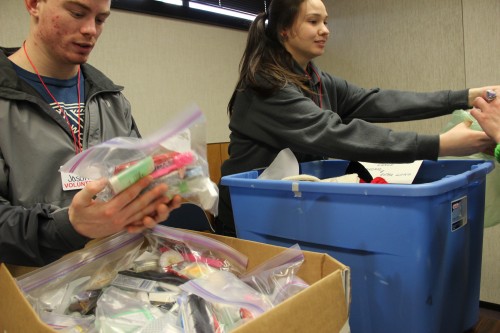
Mt. Edgecumbe High School seniors hand out socks and toiletries at Project Homeless Connect. (KCAW photo/Emily Forman).
Fewer people than expected turned out for Sitka’s second annual Project Homeless Connect event on Wednesday (1-29-14), but organizers blame the beautiful weather. About 50 Sitkans received vouchers for goods and services, consulted with health care professionals, and connected with social service organizations. Unlike some places — like downtown Seattle — Sitka doesn’t have panhandlers, or people sleeping on the street, so it isn’t very clear who’s homeless. But, on one day a year during Project Homeless Connect, the community’s most invisible population becomes visible.
Homelessness in Sitka might be inconspicuous, but Stormy is not.
Stormy says, “everything from the base of my skull to my tailbone hurts.”
Stormy is the guy with the long braided ponytail who rides around town on a blue tricycle. He walks with a cane and a limp.
KCAW: What happened to your leg?
Stormy: I got run over when I was 17.
Stormy describes his living situation as “in between.” He says he doesn’t have a home because he’s unemployed, and he doesn’t have a job because it hurts to stand. And since there isn’t a drop-in homeless shelter in Sitka he has to be resourceful.
Stormy: You end up having to either crash or someone’s couch, or you come up with a tent and go out and live under a tree.
KCAW: Is that what’s you’ve been doing?
Stormy: I’ve done that. Yes.
Project Homeless Connect is a one day, one stop shop for Sitkans that also might describe their housing situation as “in between.”
People migrate from table to table collecting information, and receiving on the spot care. There’s a physician seated behind partition ready to prescribe medication, or schedule a doctor’s visit if there’s a shorter term solution that could alleviate pain or discomfort. You can even pick up an identity if you don’t have one. Birth certificates, which are normally $25, have been donated to the event.
“You can’t get a job if you don’t have a social security card and you can’t get a social security card if you don’t have a birth certificate,” says Annabel Lund. “That can seem overwhelming if you’re living in a little tent.”
Lund volunteers with the Red Cross, and holds a seat on the local emergency planning commission. She’s passing out information on what to do in the event of an earthquake. Lund says the biggest barrier for the homeless is not having access to information, as well as other people’s misconceptions.
“Even good hearted people still in the back of their heads think this person is stupid, or a criminal, or even worse: they choose that lifestyle,” Lund says. “Please, it’s a way for you to absolve yourself from having to help in any way.”
Lund volunteers because she feels no one should be homeless in a tight-knit, wealthy community like Sitka. And this event helps shed light on the issue.
Even though it’s only a Band-Aid solution, the recipients say it’s much better than nothing.
Tom says, “They do what they can, but they can only do so much, and what little help they can provide is more than welcome.”
Tom lives out of his truck. He used to drive cab, but lost his commercial driver’s license for two years as penalty for a misdemeanor. He hasn’t managed to bounce back – which he attributes to lack of work and affordable housing options. He’s on long waiting list for housing.
Tom is candid about needing help, but he knows of many others in town who aren’t.
“Most of the people in this position ain’t even here. I don’t know if it’s lack of not knowing about this, or a pride thing,” says Tom. “But there’s also a lot of alcohol problems here in town. And you know, when you’d rather go out and drink then get help…”
This event is designed to empower those that have the courage to ask for help. But, what happens the rest of the year?
KCAW: How do you feel like the community has been doing in dealing with homelessness?
Stormy: Sweep it under the rug. It doesn’t exist. Most people don’t see it as a problem because it’s not them, it’s not affecting them.
In the meanwhile Stormy says he’s battling with social services to get proper treatment for his leg, so that he can turn things around. But, at least for one day he can look service providers in the eye and be heard.






























